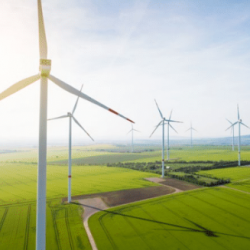March 9, 2021
New guidance for renewable energy procurement and carbon offsetting
 The UK Green Building Council (UKGBC) has published Renewable Energy Procurement and Carbon Offsetting Guidance for Net Zero Carbon Buildings. This guidance provides clarity for the property and construction industry on the procurement of high-quality renewable energy and carbon offsets for net zero buildings and organisations in the UK.
The UK Green Building Council (UKGBC) has published Renewable Energy Procurement and Carbon Offsetting Guidance for Net Zero Carbon Buildings. This guidance provides clarity for the property and construction industry on the procurement of high-quality renewable energy and carbon offsets for net zero buildings and organisations in the UK.
The new guidance released includes a set of principles which should be used to evaluate the quality of renewable energy procurement routes, including how to create additionality – driving a material increase in the UK’s renewable energy capacity.
Procurement of high-quality renewable energy
As identified by a Climate Change Committee report in December 2020, within the UK, the procurement of renewable electricity is currently having a limited impact, and in many cases, no impact at all on emissions reductions either for the organisation or for the country. This is because most of the renewable energy being procured today either already exists (e.g., from an existing wind farm) or is supported by Government subsidies. As a result, the procurement does not guarantee a causal relationship between an organisation’s action and any emission reduction delivered. This includes the vast majority of ‘green tariffs’, where the positive environmental impact is overstated.
Procurement of high-quality carbon offsets
Whilst carbon offsetting has frequently come under scrutiny for potential ‘green-washing’, the use of high-quality carbon offsets can be employed as part of a credible pathway to 1.5 degrees aligned net zero, if used responsibly. In line with UKGBC’s guidance, carbon offsets should only be used to compensate unavoidable emissions in a timeframe aligned to the point of pollution: annually for operational energy, and at the point of completion for construction.
The guidance outlines how the environmental integrity of an offset is determined, the existing carbon standards that provide this assurance of integrity, and how domestic carbon standards can play a role within organisational net zero strategies. It also sets out a ‘leadership approach’, which demonstrates how organisations and consumers can use carbon offsetting to go beyond emission reductions and support the development of a broader value proposition that is aligned to long-term business strategies and/or supports the UK and global transition to net zero.
Designed to support UKGBC’s landmark report ‘Net Zero Carbon Buildings: A Framework Definition’, this guidance is intended to be used by building developers, designers, owners, occupiers and policy makers. Given the complexities of certain elements, it will be of most use to energy procurement, facility management and sustainability professionals within these organisations. It is applicable to all building types, sizes, and ownership scopes where annual public disclosure of energy use, generation and carbon offsets is possible.
[perfectpullquote align=”right” bordertop=”false” cite=”” link=”” color=”” class=”” size=””]”This guidance marks an important step forward in helping the industry to deliver on our net zero targets.”[/perfectpullquote]
Julie Hirigoyen, Chief Execuive at UKGBC: “Designing for reductions in whole life carbon and greater energy efficiency are just two pieces of a complex puzzle when it comes to our transition to net zero carbon buildings. The importance of the principles put forward in this guidance to evaluate the quality of renewable energy procurement routes, to calculate the residual emissions, and to offset those residual emissions in a meaningful way, is paramount to ensure the credibility of any net zero carbon building claim. This guidance marks an important step forward in helping the industry to deliver on our net zero targets, and ultimately respond to the climate crisis with buildings that are fit for the future.”
Syed Ahmed, Director, Energy for London: “This new guidance from the UKGBC is a major contribution in helping developers better understand what routes are available to secure renewable energy supplies as a tool to deliver net zero carbon buildings. This is a complex area, but one of growing importance as long term procurement of renewables presents significant opportunities in driving forward new renewable generation capacity in cities and more widely, supporting the renewables sector at a challenging time.”













